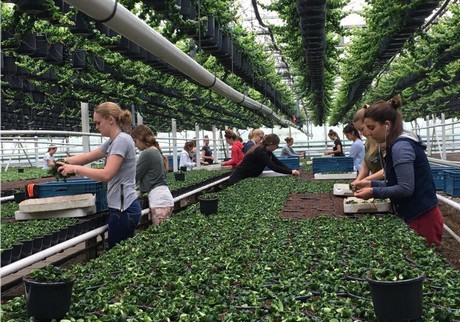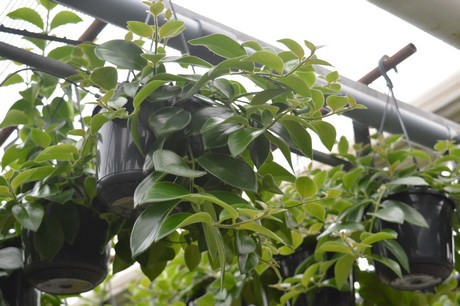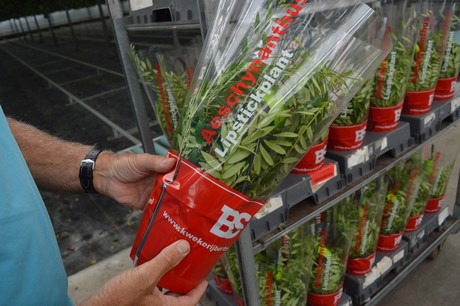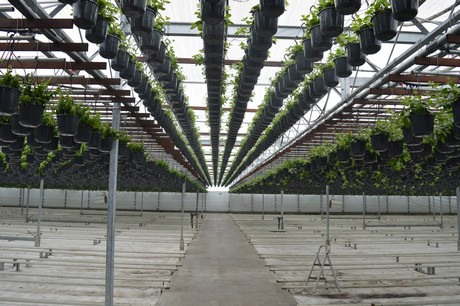
Bert Schouten in the greenhouse.
Flowering remains important
Green plants are trendy at the moment, but this trend does not seem to count for the Aeschynanthus. "The moment that this plant is on the shelf, it needs to flower. If not, the plant is worth 40 cents instead of 4 euros", says Schouten, who named the plant after its flowers. "We put it on the market as Lipstick Plant about five years ago. It's much easier to pronounce, so the name 'sticks'."
Curled leaves popular
In 2003, Schouten decided to breed his own varieties. Currently, Schouten cultivates five proprietary varieties; Twister, Rasta, Mona Lisa, Fleurly Mona Lisa and Twister XL. The Mona Lisa is one of the oldest varieties and has straight leaves. "Over the years, we added curled leaved varieties, like the Rasta, Twister and Twister XL. They rapidly increased in popularity and currently make up over 60 percent of the production volume. And still we often have shortages of the curled varieties. The Rasta, for example, is a variety that is in high demand. So to prevent any shortages, we decided to plant more of these varieties."

Niche
The advantage of growing a niche product is, explains Schouten, that decision of purchase is often not based on price. "It is a product for lovers of these kinds of plants." However, the sky is not the limit. "All other flowering plants are our competitors. So there is a certain limit." On top of that, it is important to be present. "If you are not in the assortment of a garden center, you won't be missed." For this reason, Schouten is attending several trade shows, to get the attention of a broader audience.

Adding value
Adding value is also important in achieving this. Several years ago, Schouten introduced a 30 cm high ceramic pot that makes the plant "ready to use" and therefore a more accessible product. Besides that he always tries to respond to existing trends. "We just started to sell plants in pots with macramé plant hangers."
Greenhouse
Recently, we paid a visit to the greenhouse where Schouten gave us a guided tour. Below an impression of how the Aeschynanthus are cultivated.

Year-round, the Aeschynanthus are propagated on these tables. When they have reached the desired size, the hooks are attached to the pots and they are put on the rails.
Students
Schouten's nursery is characterized by the high number of students that work in the greenhouse. Around 50 students support the five full-time workers in the nursery. "On Saturday mornings, and three mornings a week during the holiday season, the female students propagate the plants and the male students hang the plants on the rails. We've been working with students for 15 years now and we are very pleased. We pay them per cutting or per pot they hang on the ceiling. It would not be affordable to hire full timers for these kinds of jobs", explains Schouten.

Female students are propagating the plants.

Male students hanging the plants on the rails.

Mona Lisa.

The plants are watered by using drip irrigation, and in order to reduce the light levels, a coating is put on the greenhouse and two types of screens are used.

The crop is hanging on the rails.

Then, when they are ready, they are harvested and hanged on an object designed by Schouten. "It is not convenient to put them on trolleys, so we created this object on which we can hang the flowers."

Several plants are supplied in these 30 cm ceramic pots.

Others are shipped out in these new pots with macramé plant hangers.

But the majority of the plants leave the greenhouse in this package.

This part of the greenhouse is still empty and will be filled soon. The entire area under glass consists of three greenhouses: a 10,000 m2, 10,000 m2 and a 16,000 m2 greenhouse.
Some more pictures of the crop in the greenhouse:




For more information

Bert Schouten Kwekerij
Bert Schouten
Email: [email protected]
www.kwekerijbertschouten.nl
